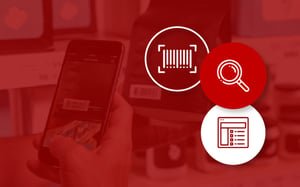After licensing a universal product code (UPC), you can expect to reap the benefits of improved productivity and efficiency. That’s because a UPC can help you identify products and their attributes in your store. What’s more, it allows you to track your inventory, no matter where it is. That speaks to the role it can play in helping you run an efficient business.

What is a UPC code?
For all the good that comes with setting up a UPC, it’s vital to consider what it is and when you need one.
As we mentioned above, UPC is an acronym for universal product code. It’s a unique code consisting of a 12-digit number and assigned to a specific product. Of course, it’s not a number you can create for a product, which you can do with SKUs.
Instead, for your UPC code to be considered valid, you need to license it through Global Standards One (GS1). The GS1 maintains not only the registration of your UPC but also the guidelines for product identification.
A UPC displays in two different manners - a barcode and printed numbers. The barcode is for scanning purposes. Meanwhile, the printed numbers are easily readable. This is especially beneficial when you need to scan a product manually because your barcode scanners are faulty.
As for its purpose, one is to help you identify the attributes of a product such as brand, price, size and colour when scanning an item at checkout. Not only do these codes help identify products, but they also enable you to track your inventory levels within a business. Once you have a registered UPC, it is universally recognised.
That speaks to questions: when do you need a UPC code? That’s simple.
If you want to sell your merchandise outside of your own retail business, you need to get a UPC code. Since the code is universal, you can track your product wherever you sell it. These products are traceable to your establishment, thus marking them as your intellectual property.
If you don’t plan to sell your products outside of your retail business, you don't need to register for a UPC code. However, it is still handy to have one. It will protect your merchandise from other companies that buy out your products as they can still trace back to you.
It’s also worth noting that the general rule for UPCs is that each product that you intend on selling will need to have a unique code.
This is applicable for each variant of a product too. If it is the same product but a different size or colour, each size and colour will require its own code. The same is true for different packaging materials and different configurations of a product.
For example, if the same product is available in both a plastic container and a glass container, it will need a new code.
Another example would be if a product is on promotion or is a bundle package. For example, you have one product on its own, and the same product with an added extra. The product with an added extra will need its own UPC code. This can also be applicable for product changes. In the future, a product may change, and that change might affect how both retailers and customers perceive the product. Therefore, you may need to assign a new UPC code to the changed product.

What are the main differences between SKUs and UPCs?
We have already established what a UPC code is, but what is a SKU?
SKU, pronounced ‘skew’ is an abbreviation for stock keeping unit. A SKU is an internal product code that companies assign to their inventory to track their inventory levels. This code is unique to its particular company as the company establishes the code. Although SKUs and UPCs are different, they are used for many of the same purposes.
1. Internal vs External use
The first difference between SKUs and UPCs comes down to their uses. SKUs are for internal purposes, whereas UPCs are for external purposes.
As previously mentioned, SKUs are unique to individual retailers. You can generate SKUs and assign them to just about any asset within your business, whether it be physical products or intangible services. On the other hand, you can only assign UPCs to physical products.
Also, you can generate SKUs to use internally while you need to buy a license from the GS1 for a UPC.
You can also use UPC codes for external purposes such as to track sales. UPCs are tracked externally by retailers at the point of sale, and when products are sold globally, you can track the product through the company’s prefix. On the other hand, you'd use SKUs for internal tracking purposes.
Lastly, you'll find SKUs typically printed on store's shelves as well as on retailer tags, whilst UPCs are on product packaging.
2. Alphanumeric vs Numeric
A SKU is an alphanumeric serial number that is unique to your business. Alphanumeric is a combination of letters and numerals. The letters and numbers are typically abbreviated attributes of your product. Also, the number can be as long or as short as you please.
UPCs are 12-digit numeric serial numbers that stay the same for every company handling that specific product. Unlike a SKU, a UPC code is composed entirely of numbers.
The first six digits of your UPC is a unique identifier assigned to your business by the GS1. You will hear these six digits commonly referred to as the company’s prefix. You would choose the next five digits while the last digit is the check digit. You can calculate the check digit using an algorithm to guarantee that none of your UPCs are the same.
3. Free to create vs Purchased
When it comes to SKUs, you can create as many as you want for free. Meanwhile, for a UPC code to be considered valid, it must be paid for and licensed through the GS1.
The recommendation is that all retail UPCs should come from GS1. There are, of course, numerous UPC resellers available and you're welcome to use them. However, if you choose to purchase from the resellers, you could run into future problems. As small business marketing strategist, Gail Gardner points out, you must be cautious when selecting one.
For example, let's say you choose to purchase your UPC from a third party. The company prefix element of the code could be registered to their company instead of yours.
It would be ideal to purchase from GS1 so that your UPC includes your company’s prefix thereby legitimising your business.
Another difference between a SKU and UPC is a company's ability to generate its code. You can generate SKUs by yourself. You can only partially create a UPC, namely the five digits following the company’s prefix.

What role do UPCs play in category management?
1. They can help improve inventory management
Universal product codes can improve inventory management in numerous ways.
Firstly, it is a simple process - you can review your inventory levels with one quick scan of the code. The scanning is usually done at the point of sale to identify the product in the system and subsequently remove it from the inventory upon a customer purchase. This helps to improve inventory control as it ensures an accurate account of what and how much of a product is available.
This is beneficial to you since you have live inventory records and can monitor your stock levels and prevent out of stock situations. Indirectly, UPC codes can improve customer satisfaction, as you can ensure you have the right stock at the right time, which will improve the overall shopping experience for your customers.
2. They help shorten the checkout process
UPC codes help to speed up the checkout process. You can scan the UPC during the checkout process, thereby eliminating the need for a cashier to manually type out the product code into the system to pick it up.
Once scanned, the UPC code reveals the product information, including price, brand name and size. After processing the payment, the system automatically reduces your available stock. If the stock levels are low, it will automatically communicate that you need to replenish your stock.
Another benefit of speeding up the checkout process again is customer satisfaction. Customers don’t want to wait at the checkout for long periods.
3. They help improve accuracy/efficiency and reduce mistakes
UPC codes work on a scanning basis, which means using them can help you to reduce any unnecessary human errors during stock control, ordering, forecasting and check out.
Instead of manually entering numbers or typing them out, you can scan a code. Not only does it then eliminate any unnecessary errors, but you can also improve your inventory control.
4. They allow you to track your products no matter where they are sold
When companies register for a UPC, that code is universally recognised for a specific product. This means the product is easily identifiable to the supplier, warehouse, stores and to your customers.
To have an effective supply chain management system means to be aware of your products wherever it is in the supply chain. Having a UPC makes it easier for you to track inventory or stock on hand. Having these codes ensures that you can easily view your stock levels.
This will assist you when it comes to forecasting future orders. When you receive or send out a product, you should scan it to ensure accurate inventory management.
Conclusion
Utilising UPC codes and licensing them ultimately enables you to enhance your performance capability on the grounds of productivity, efficiency and control. The aforementioned is a result of being able to identify products and their attributes, as well as track their movements more efficiently. As such, if you seek improvement and growth, it is vital to register for a UPC code.
Looking for advice or need a category management solution that can help your business? Visit our online store here for more information or book a custom exploratory consultation.


